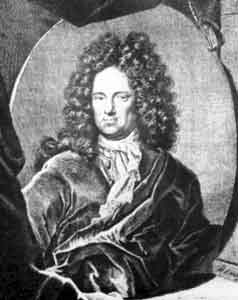.
Ehrenfried Walther von Tschirnhaus

Ehrenfried Walther von Tschirnhaus.
Ehrenfried Walther von Tschirnhaus (or Tschirnhausen) (April 10, 1651–October 11, 1708) was a German mathematician, physicist, physician and philosopher. He is the inventor of the European porcelain, an invention that for a long time had been assigned to Johann Friedrich Böttger. He was born in Kieslingswald and died in Dresden.
Education
Von Tschirnhaus attended the Gymnasium at Görlitz. Thereafter he studied mathematics, philosophy, and medicine at the University of Leiden. During his travels he met Baruch de Spinoza and Christiaan Huygens in the Netherlands, Isaac Newton in England, and Gottfried Wilhelm Leibniz in Paris, with whom he maintained a life-long correspondence. He became a member of the Académie Royale des Sciences in Paris.
The Mathematician
In 1682 he worked out the theory of caustics by reflection, or, as they were usually called, catacaustics, and showed that they were rectifiable. This was the second case in which the envelope of a moving line was determined. The Tschirnhaus transformation, by which he removed certain intermediate terms from a given algebraic equation, is well-known; it was published in the scientific journal Acta Eruditorum in 1683.
The curve y2 = x3 + 3x2 is called the Tschirnhausen cubic.
Von Tschirnhaus produced various types of lenses and mirrors, some of them are displayed in museums.
His work Medicina mentis sive artis inveniendi praecepta generali (1687) combines methods of deduction with empiricism and shows him to be philosophically connected to the Enlightenment.
Inventor of Porcelain
After he returned home to Saxony, Von Tschirnhaus initiated systematic experiments, using mixtures of various silicates and earths at different temperatures to develop porcelain, which at that time was only available as a luxury import from China and Japan. Already in 1704 he showed “porcelan” to Leibniz’s secretary. He proposed to August II, the Elector of Saxony, the establishment of a Porcelain Factory, but was denied. In 1704 he became the supervisor of Johann Friedrich Böttger, a 19 year-old alchemist who claimed that he was able to make gold. Böttger only reluctantly and under pressure started to participate in Von Tschirnhaus’ work by 1707. The use of Kaolin from Schneeberg, Saxonia, and alabaster advanced the work, so that August II named him the director of the to porcelain factory he intended to establish. He ordered a payment of 2,561 thalers to be made to Von Tschirnhaus, but the recipient requested to postpone the payment until the factory was producing. Unexpectedly, Von Tschirnhaus died on October 11, 1708. The project came to a halt.
Three days after Von Tschirnhaus’ death, there was a burglary at his house, and, according to a report by Böttger, a small piece of porcelain was stolen. This report suggests that Böttger himself recognized that Von Tschirnhaus already knew how to make porcelain, a key piece of evidence that Von Tschirnhaus is the inventor. Work resumed on March 20, 1709, when Melchior Steinbrück had arrived to assess the deceased’s estate, which included the notes about making porcelain. He also at that time met with Böttger. On March 28, 1709, Böttger went to August II and announced the invention of porcelain. Böttger now was nominated to head the first European manufactory for porcelain. Steinbrück became an inspector and married Böttger’s sister.
Contemporary testimonies of knowledgeable people indicate that Von Tschirnhaus invented porcelain. Thus 1719 Samuel Stölzel of the porcelain factory of Meissen went to Vienna with the still-secret recipe and confirmed that it had been invented by Von Tschirnhaus and not Böttger. The General Secretary of the Meissen factory also indicated in 1719 that the invention was not by Böttger “but by the late Herr Von Tschirnhaus whose written science“ was handed to Böttger „ by the inspector Steinbrück.” Nevertheless, Böttger’s name became closely associated with the invention.
References
* This article or a previous version of it is partially based on the public domain A Short Account of the History of Mathematics (4th edition, 1908) by W.W. Rouse Ball, as transcribed at Some Contemporaries of Descartes, Fermat, Pascal and Huygens: Tchirnhausen
* A significant part of the article is based on the corresponding German wikipedia website from February 2, 2006 that contains references about the Böttger - Tschirnhaus controversy.
* O'Connor, John J; Edmund F. Robertson "Ehrenfried Walther von Tschirnhaus". MacTutor History of Mathematics archive.
Links
* Biographie in der ADB, Bd. S. 722-724 (Leipzig 1894) unter http://mdz.bib-bvb.de/digbib/lexika/adb/images/adb038/
‹ The template below (PND) is being considered for deletion. See templates for deletion to help reach a consensus. ›
Ehrenfried Walther von Tschirnhaus in the German National Library catalogue
* Website of the Tschirnhausgesellschaft (in English and German)
* http://rcswww.urz.tu-dresden.de/~krautz/saw_tsch
* http://www.goethezeitportal.de/fileadmin/PDF/db/wiss/tschirnhaus_grimm.pdf Gunter E. Grimm: Argumentation und Schreibstrategie. Zum Vulkanismus-Diskurs im Werk von Ehrenfried Walther von Tschirnhaus]
Retrieved from "http://en.wikipedia.org/"
All text is available under the terms of the GNU Free Documentation License


